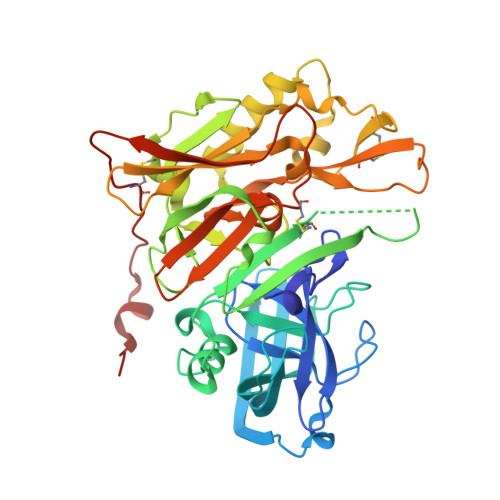Discovery of 7-tetrahydropyran-2-yl chromans: beta-site amyloid precursor protein cleaving enzyme 1 (BACE1) inhibitors that reduce amyloid beta-protein (A beta ) in the central nervous system.
Thomas, A.A., Hunt, K.W., Volgraf, M., Watts, R.J., Liu, X., Vigers, G., Smith, D., Sammond, D., Tang, T.P., Rhodes, S.P., Metcalf, A.T., Brown, K.D., Otten, J.N., Burkard, M., Cox, A.A., Do, M.K., Dutcher, D., Rana, S., DeLisle, R.K., Regal, K., Wright, A.D., Groneberg, R., Scearce-Levie, K., Siu, M., Purkey, H.E., Lyssikatos, J.P., Gunawardana, I.W.(2014) J Med Chem 57: 878-902
- PubMed: 24397738
- DOI: https://doi.org/10.1021/jm401635n
- Primary Citation of Related Structures:
4N00 - PubMed Abstract:
In an attempt to increase selectivity vs Cathepsin D (CatD) in our BACE1 program, a series of 1,3,4,4a,10,10a-hexahydropyrano[4,3-b]chromene analogues was developed. Three different Asp-binding moieties were examined: spirocyclic acyl guanidines, aminooxazolines, and aminothiazolines in order to modulate potency, selectivity, efflux, and permeability. Using structure-based design, substitutions to improve binding to both the S3 and S2' sites of BACE1 were explored. An acyl guanidine moiety provided the most potent analogues. These compounds demonstrated 10-420 fold selectivity for BACE1 vs CatD, and were highly potent in a cell assay measuring Aβ1-40 production (5-99 nM). They also suffered from high efflux. Despite this undesirable property, two of the acyl guanidines achieved free brain concentrations (Cfree,brain) in a guinea pig PD model sufficient to cover their cell IC50s. Moreover, a significant reduction of Aβ1-40 in guinea pig, rat, and cyno CSF (58%, 53%, and 63%, respectively) was observed for compound 62.
- Array BioPharma , 3200 Walnut Street, Boulder, Colorado 80301, United States.
Organizational Affiliation:


















